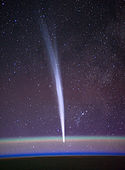International Space Station

The International Space Station (ISS) is a modular space station (habitable artificial satellite) in low Earth orbit. It is a multinational collaborative project between five participating space agencies: NASA (United States), Roscosmos (Russia), JAXA (Japan), ESA (Europe), and CSA (Canada). The ownership and use of the space station is established by intergovernmental treaties and agreements. The station serves as a microgravity and space environment research laboratory in which scientific research is conducted in astrobiology, astronomy, meteorology, physics, and other fields. The ISS is suited for testing the spacecraft systems and equipment required for possible future long-duration missions to the Moon and Mars.
The ISS programme evolved from the Space Station Freedom, an American proposal which was conceived in 1984 to construct a permanently manned Earth-orbiting station, and the contemporaneous Soviet/Russian Mir-2 proposal with similar aims. The ISS is the ninth space station to be inhabited by crews, following the Soviet and later Russian Salyut, Almaz, and Mir stations and the U.S. Skylab. It is the largest artificial object in space and the largest satellite in low Earth orbit, regularly visible to the naked eye from Earth's surface. It maintains an orbit with an average altitude of 400 kilometres (250 mi) by means of reboost manoeuvres using the engines of the Zvezda Service Module or visiting spacecraft. The ISS circles the Earth in roughly 93 minutes, completing 15.5 orbits per day.
The station is divided into two sections: the Russian Orbital Segment (ROS), operated by Russia; and the United States Orbital Segment (USOS), which is shared by many nations. Roscosmos has endorsed the continued operation of ROS through 2024, having previously proposed using elements of the segment to construct a new Russian space station called OPSEK. The first ISS component was launched in 1998, and the first long-term residents arrived on 2 November 2000. The station has since been continuously occupied for 20 years and 18 days, the longest continuous human presence in low Earth orbit, having surpassed the previous record of 9 years and 357 days held by the Mir space station. The latest major pressurised module, Leonardo, was fitted in 2011 and an experimental inflatable space habitat was added in 2016. Development and assembly of the station continues, with several major new Russian elements scheduled for launch starting in 2020. As of December 2018update, the station is expected to operate until 2030.
The ISS consists of pressurised habitation modules, structural trusses, photovoltaic solar arrays, thermal radiators, docking ports, experiment bays and robotic arms. Major ISS modules have been launched by Russian Proton and Soyuz rockets and US Space Shuttles. The station is serviced by a variety of visiting spacecraft: the Russian Soyuz and Progress, the U.S. Dragon and Cygnus, the Japanese H-II Transfer Vehicle, and, formerly, the European Automated Transfer Vehicle. The Dragon spacecraft allows the return of pressurised cargo to Earth, which is used, for example, to repatriate scientific experiments for further analysis. As of September 2019update, 239 astronauts, cosmonauts, and space tourists from 19 different nations have visited the space station, many of them multiple times. This includes 151 Americans, 47 Russians, 9 Japanese, 8 Canadians, 5 Italians, and others.
Comments
Post a Comment